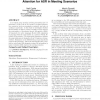873 search results - page 8 / 175 » Language model adaptation using Random Forests |
EMNLP
2008
13 years 9 months ago
2008
Traditionally, statistical machine translation systems have relied on parallel bi-lingual data to train a translation model. While bi-lingual parallel data are expensive to genera...
ICASSP
2010
IEEE
13 years 7 months ago
2010
IEEE
This paper investigates unsupervised vocabulary and language model self-adaptation (VLA) from just one speech file using the web as a knowledge source and without prior knowledge...
ICMI
2009
Springer
14 years 2 days ago
2009
Springer
In a typical group meeting involving discussion and collaboration, people look at one another, at shared information resources such as presentation material, and also at nothing i...
ICPR
2006
IEEE
14 years 8 months ago
2006
IEEE
Coarticulation is one of the important factors that makes automatic sign language recognition a hard problem. Unlike in speech recognition, coarticulation effects in sign language...
ACL
2008
13 years 9 months ago
2008
We take a multi-pass approach to machine translation decoding when using synchronous context-free grammars as the translation model and n-gram language models: the first pass uses...

